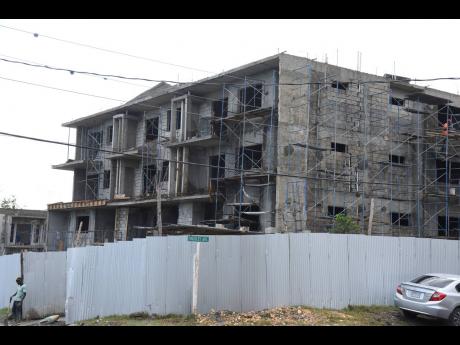Urban traffic crisis
Pedestrian-unfriendly developments raise concern as concrete jungles spring up
Jamaica’s urban planning and traffic authorities have been pressed to speed up pedestrianisation and to promote short-route transportation to ease congestion on the streets of the Corporate Area.
Greater Kingston’s corridors are often scenes of gridlock during morning and evening rush hour, a crisis exacerbated by the thousands of motorists who stream into the capital from St Mary, St Thomas, and the high-density parish of St Catherine.
Enith Williams, past president of the Golden Triangle Neighbourhood Association, is bristling against the expanding footprint of multistorey developers whose high-rises demand more wider roads, thus making room for more vehicular traffic.
Williams insists that planning authorities designate safe pedestrian zones for commuters in “well-laid-out and functioning cities”.
Another bugbear of Williams’ is the increased reliance of the National Works Agency (NWA) on concrete medians along “four-lane highways in the middle of the city”.
That criticism has been a refrain for some architects and citizen advocacy groups who point to rehabilitation of Constant Spring Road, Hagley Park Road, and the main thoroughfare in Barbican as examples of pedestrian-unfriendly development.
“Where are you going to walk on Lady Musgrave Road when it is a four-lane highway with a concrete median? If you are, in fact, urbanising and having higher density, then why are you still requiring that the buildings have parking to accommodate cars ... ,” Williams told a Gleaner Editors’ Forum last Thursday.
“The Kingston 25 years from now is going to be haphazard and ‘chaka-chaka’. That is no way to grow a city.”
Christopher Whyms-Stone, deputy chairman of the Natural Resources Conservation Authority, however, believes that long commutes beyond Greater Kingston are a problem that can be significantly addressed by the construction of more multistorey developments.
“The NWA says that 88 per cent of our country does not move by private car ... . The problem is that a lot of them move by taxis, and that jams up the roads. This is why you need higher density, to make other kinds of transport affordable,” he said.
Whyms-Stone’s view is supported by Jeremy Lawrence, senior building inspector for the Kingston and St Andrew Municipal Corporation (KSAMC).
VERY INEFFICIENT
Lawrence, like other municipal officers, is aware of the resistance in many of Kingston’s traditionally single-family communities whose homes have been dwarfed and cast in the shadows by high-rises.
Travelling into Kingston to work is “very inefficient”, said Lawrence, especially when two-to-three-hour commutes and toll fees of upwards of $700 are factored.
“Providing homes outside of the city is going to create some of the problems that we are facing now, which is means of transport. You are talking about either upgrading the toll again or putting in another toll road,” Lawrence told the forum.
Productivity consultant Francis Wade revealed that up to 30-40 per cent of some commuters’ man-hours are lost daily in long commutes to and from Kingston.
This has implications for Jamaica’s labour productivity, which the Jamaica Productivity Centre reveals has declined by 1.5 per cent annually since the 1970s. However, Wade disagreed with the suggestion that higher densification is the solution to Jamaica’s productivity challenges.
“Living close to where you work is not a sustainable solution for obvious reasons. The more people you have closer to work, the more traffic you create. In the long term, there needs to be more work-from-home to maintain productivity,” said Wade.
Highway operator TransJamaican Highway Limited estimated that 20.6 million vehicles were tolled in 2020 on Highway 2000 East West, which runs from Kingston to May Pen, with the daily average being 56,270 vehicles.

